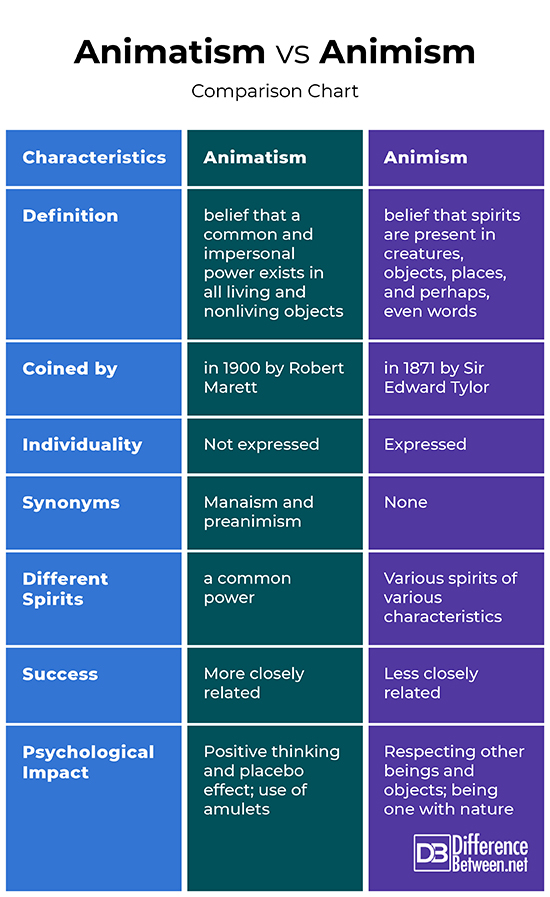Difference Between Animatism and Animism
Both animatism and animism are anthropological terms which refer to the spirits which reside in beings and objects. They are both based on the Latin word “anima” which means “soul”, “life”, or “breath”. Also, these beliefs are significant in primitive as well as modern spiritual practices. However, animism is specifically defined as the belief that natural objects are inhabited by spirits while animatism is more inclusive as it is the belief that power, which is impersonal, is everywhere. The following sections will further explore such distinctions.

What is Animatism?
Animatism is the belief that a common and impersonal power exists in all living and nonliving objects. For instance, the life force that is present in the trees is also the same spirit which powers the rain, rocks, and animals. Most people who practice animatism believe that the supernatural forces residing in various objects interact with each other. They may then receive information from these forces regarding diseases, calamities, and other pertinent catastrophes.
This term was coined in 1900 by Robert Marett, a British anthropologist, who studied the culture of Melanesians and Polynesians. Particularly “Mana” is a healing power which exists in the universe; any being, or thing can have it and it is cultivated rather than owned. Animatism is also referred to as Manaism or preanimism. Marett described animatism is a primitive form of religion which believes that humans do not possess personal souls. He compared it with electricity which is enlivened but not in an individual-like manner.

What is Animism?
Animism is the belief that spirits are present in creatures, objects, places, and perhaps, even words. For instance, an animist believes that plants, mountains, rocks, and the rain are spiritual beings. Most societies which practice animism believe that the spirits can interact with people and that they should be cautious not to displease them since they can have the power to punish humans. Also, such spirits can have their respective characteristics such as gender, temperament, and morality. Expressions of animism are apparent in religions such as Shinto, Neopaganism, Hinduism, and Buddhism. For example, spirit houses are built for Hindu deities who look after lands or establishments.
This term was developed in 1871 by Sir Edward Tylor, an English anthropologist and the founder of cultural anthropology. He described animism as the earliest form of religion which was basically a mistake from which current religions are based on. He first wanted to call it as “spiritualism” but he realized that it might be confused with the modern religion, “Spiritualism”. He then based it on “animismus” a biological theory by George Stahl, a German scientist, who stated that souls are the fundamentals of the vital principle and that they are the causes of diseases and phenomena.
Difference between Animatism and Animism
Definition
Animatism is the belief that a common and impersonal power (which can both influence and be influenced) exists in all living and nonliving objects while animism is the belief that spirits are present in creatures, objects, places, and perhaps, even words.
Coined by
Animatism was coined in 1900 by Robert Marett, a British anthropologist, who studied the culture of Melanesians and Polynesians. Marett compared it with electricity which is enlivened but not in an individual-like manner. On the other hand, animism was developed in 1871 by Sir Edward Tylor, an English anthropologist and the founder of cultural anthropology. He described animism as the earliest form of religion which was basically a mistake from which current religions are based on.
Individuality
Animatism does not believe in the individuality of the spirits since it describes the supernatural force as impersonal and common. In comparison, animism believes in the personal attributes of spirits; they have intentions, emotions, gender, etc.
Synonyms
As compared to animism, animatism has other terms as it is also referred to as Manaism or preanimism.
Different Spirits
Animatism only speaks of a common power which resides in diverse entities. On the contrary, animism describes various spirits of differing characteristics.
Success
As compared to animism, animatism, which is based on “Mana” is more closely related with success. For instance, believing that you have the “Mana” brings you the security and optimism which secures victory. Moreover, this impersonal force may determine if a harvest is bountiful.
Psychological Impact
Animatism promotes the use of amulets which is a way of securing “Mana”. Hence, it is associated with placebo effect and positive thinking. In comparison, animism promotes respecting other beings and objects since they are inhabited with spirits which may reward or punish them. Hence, it is also more closely linked with the mentality of being part of nature.
Animatism vs Animism: Comparison Chart

Summary of Animatism vs Animism
- Both animatism and animism refer to anthropological terms which refer to the spirits which reside in objects.
- Animatism is the belief that a common and impersonal power exists in all living and nonliving objects.
- Animism is the belief that spirits are present in creatures, objects, places, and perhaps, even words.
- Animatism was coined in 1900 by Robert Marett while animism was coined in 1871 by Sir Edward Tylor.
- The individuality of the supernatural force is not expressed in animatism while it is expressed in animism.
- Unlike animism, animatism has synonyms: Manaism and preanimism.
- Animatism speaks of a common power while animism reflects various spirits of various characteristics.
- The psychological impact of animatism is the use of amulets, optimism, and placebo effect while that of animism is respect and being one with nature.
- Difference Between Hematoma and Melanoma - February 9, 2023
- Difference Between Bruising and Necrosis - February 8, 2023
- Difference Between Brain Hematoma and Brain Hemorrhage - February 8, 2023
Search DifferenceBetween.net :
Leave a Response
References :
[0]Image credit: https://live.staticflickr.com/9/12978542_23e01d3e4b_z.jpg
[1]Image credit; https://commons.wikimedia.org/wiki/File:Jarai_tomb_(guardian_spirit_sculpture).jpg
[2]Ferraro, Gary. Cultural Anthropology: An Applied Perspective, 7th ed. Belmont, CA: Thompson Wadsworth, 2008. Print.
[3]Harvey, Graham. Animism: Respecting the Living World. New York, NY: Columbia University, 2005. Print.
[4]Orr, Emma. The Wakeful World: Animism, Mind and the Self in Nature. Hampshire, UK: Moon Books, 2012. Print.
[5]Moon Books, 2012. Print.
